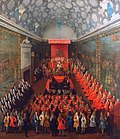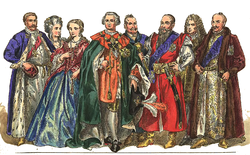Nobility

Nobility was the highest social class in pre-modern societies. In the feudal system (in Europe and elsewhere), the noble were mostly those who got land from the monarch and had to provide services to him, mainly military service. Men of this class were called noblemen. It soon became a hereditary class, sometimes with a right to bear a hereditary title and to have financial and other privileges in the estates of the realm.
Today, in most countries, 'noble status' means no legal privileges; an important exception is the United Kingdom, where certain titles (titles of the peerage) guaranteed until recently a seat in the Upper House of Westminster Parliament (that is why it is called House of Lords) and still provide some other, less important privileges.
History
Nobles were always recognized as lower families of the King/Queen. Nobles usually rule Duchies, Counties, and principalities. Nobles were usually given a "noble house. Nobles usually worked as advisors to the King, and land owners. Some families did not work at all because they were quite wealthy. But not all nobles were wealthy. Some were very poor. One of the richest claim to be noble families were the Medicis. They ruled Tuscany, Milan and others. The Medicis were originally common people, but they were richer than most monarchs of the time until they fell in the 1700's.
Noble families had plenty of power depending on what land they ruled. The rich Duchy of Burgundy was a major power spot because of how big to Duchy was. Another power spot was the Duchy of Milan and the Duchy of Luxembourg. Some nobles had little to no power. Most nobles are given a title such as "lady-in-waiting," that is non hereditary.
Famous Noble Families
Nobility by rank
Nobility Media
The House of Lords is the upper legislature of the Parliament of the United Kingdom and is filled with members that are selected from the aristocracy (both hereditary titleholders and those ennobled only for their individual lives).
Opening of the Hungarian Diet (Országgyűlés) with the members of hungarian nobility in the Royal Palace, 1865.
Polish magnates 1576–1586.
Polish magnates 1697–1795.
Hungarian prince Ferenc József in the typical dress of the Hungarian nobility, 18th century.
Count Carl Robert Mannerheim (1835–1914), a Finnish aristocrat, businessman, and the father of Baron C. G. E. Mannerheim, the Marshal of Finland.
Emperor Haile Selassie I of Ethiopia (center) and members of the imperial court.
Other websites
- The German nobility
- Old Noble Family Trees[dead link]
- WW-Person Archived 2010-12-03 at the Wayback Machine, an on-line database of European noble genealogy
- Paul Theroff's An Online Gotha Archived 2006-11-08 at the Wayback Machine
- Genealogics, an extensive database of European nobles
- Worldroots, a selection of art and genealogy of European nobility
- RoyalArk- ruling houses in many non-European countries
- Web site on the Royalty, the Nobility, the History and the Patrimony Archived 2021-05-12 at the Wayback Machine
- The Armenian nobility[dead link]
- The Maltese Nobility and its ilks.
- Italian dynastic genealogies (in Italian, with an introduction in English)
- Worldwidewords
- OneTree Genealogy - European Royal and Danish-Norwegian-Swedish Nobility Lineages Archived 2022-01-22 at the Wayback Machine







